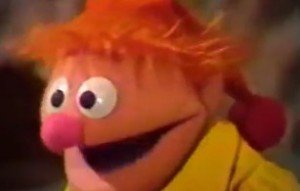The Great Santa Claus Switch
All the way back in 1963, one of the scripts that Jim Henson and Jerry Juhl collaborated on was a Christmas special called The Great Santa Claus Switch. Unlike some of their other 1960s scripts, however, they did manage to see this one to fruition, albeit 7 years later. Ed Sullivan was a great supporter and fan of the Muppets, as evidenced by their numerous appearances on his show, and agreed to produce the special in 1970. In June of that year, during the hiatus between Sesame Street‘s 1st and 2nd seasons, filming went underway, and it finally aired on Dec 20th, which was coincidentally the day after Jim and Jane’s fifth and final child, Heather, was born.
Jim had apparently hoped that The Great Santa Claus Switch would become a Christmas classic that would air every year, but unfortunately this was not to be, and now having seen it, I have my suspicions as to why. For one, while it certainly has some very funny moments, it doesn’t have the sort of indelibly memorable Muppet magic or humor that define their greatest productions. It’s charming and sweet but doesn’t feel lasting the way that his later great Christmas shows such as Emmet Otter’s Jug-Band Christmas and A Muppet Family Christmas would.
I could point to the fairly formulaic story about an evil magician named Cosmo Scam, played by Art Carney, who attempts to steal Christmas by kidnapping Santa Claus, also played by Art Carney, and taking his place–although today it feels familiar to Tim Burton’s The Nightmare Before Christmas, it is of course from many years before, so it can’t be blamed for that, but it appeared years after Dr. Seuss’ How the Grinch Stole Christmas, another similar, superior tale–but I don’t think the-not-entirely original concept is necessarily to blame, because there are many cases of a plot transcending familiar trappings via presentation and writing. But this particular production doesn’t have enough to distinguish itself.
As I mentioned before, it isn’t quite funny enough–or at least not consistently so–to ride on its humor and perhaps more damningly, it doesn’t have a single truly strong central character. Our hero is ostensibly Fred, a lovable elf new to Santa’s workshop, and he is definitely a sweet, bright little fellow, played with energy and heart by Jim, but the script also keeps him stuck in a passive role for far too long. Although he technically saves the day, his major accomplishments basically revolve around throwing a key down to an incarcerated Santa and later unhooking the reindeer from the sleigh so Cosmo can’t make off with it. He spends most of the show locked up and/or hiding from the villains. And, while he’s very likable and friendly, he’s also ever so slightly bland, particularly stacked up against a Muppet canon filled with far more memorable characters.
In many ways, Santa is the one who really saves the day but via a deus ex machina. When originally captured, he can’t stand up to Cosmo because, unlike Cosmo, he can’t perform magic (one of the show’s best running gags are his failed attempts at simple magic tricks), but once Christmas Eve officially begins, he drops the revelation that now he finally can, because he’s filled with the magic of Christmas that even enables him to get all of Cosmo’s henchmen to aid him with the wave of his hand, which makes sense from a Christmas-special perspective but can’t help but feel a bit too easy, unearned, and saccharine.
In addition to effectively making Santa the hero, even though he’s neither that interesting a character nor is he a Muppet–a genuine issue for a Muppet production; they tend to suffer when the human is too central–he wins completely passively simply because that’s just how things are at Christmas. Why, Cosmo’s magic even stops working because Santa’s magic is the only kind that works on Christmas!
And that’s actually kind of a sweet notion that could have worked had Fred been more prominent in what was meant to be his story but with the way it’s presented here, the major conflict turns out to have never really been a problem after all, as it always would have been solved as soon as the clock struck Christmas, which doesn’t make for the most compelling storytelling, and there’s very little to narratively distract from that.
Furthermore, Art Carney just isn’t giving the greatest performances here. His Santa is servicable enough–boring but servicable–but his Cosmo Scam lacks the broad, scenery-chewing appeal that typifies the best Muppet villains. In theory, his plan to pose as Santa in order to get into everyone’s houses and steal everything they own has the mean-person-who-wants-to-prevent-the-Muppets-from-spreading-joy aspect that most Muppet villains possess–such as Doc Hopper from The Muppet Movie or Tex Richman from 2011’s The Muppets–in addition to nicely echoing Taminella’s scheme in Tales of the Tinkerdee. In practice, however, he comes across more as a petty, grumpy old man who isn’t even actually enjoying himself rather than someone gleefully delighting in his own malice. And so instead of encouraging us to love to hate him, he’s just kind of irritating.
This isn’t to say that The Great Santa Claus Switch was either an artistic nor commercial failure. It may not have been the resounding success Jim had been hoping for, but it did well in the ratings, even if not enough to justify annual showings, and more importantly, had a number of crucial long-term effects that make it an absolutely fascinating piece of Muppet history to watch today.
For one, it was the largest, most ambitious Muppet project that Jim had ever attempted up to this point, requiring around 20 performers to bring all of the elves and Cosmo’s monstrous henchmen to life. In some shots, the entire screen is practically bursting with Muppets, all moving, singing, laughing, talking, what have you.
Particularly having watched the evolution of the Muppets chronologically from Sam and Friends to this point now as I have, it’s really quite something to witness the evolution from having usually two or three puppets in front of inexpensive backdrops in grainy black and white to this level of visual, worldbuilding scope appearing for the first time and in full color, with beautiful, three-dimensional, multi-leveled sets, and Muppets popping out out all over the place.
There are Muppets everywhere here with only two human characters appearing in the main show (not counting the framing scenes in which Ed Sullivan is narrating the story to a room full of children), both of whom are played by the same person, thus laying the groundwork for almost-completelely-Muppet-populated shows and worlds of The Muppet Show and Fraggle Rock.
Pages: 1 2



